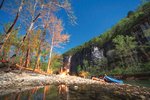





Founder of Buffalo Outdoor Center and longtime Buffalo River enthusiast, Mike Mills said, “It was March 1972 when an Act of Congress was signed making ‘The Buffalo’ a National River. The first bill was introduced in 1966 by Senator Fullbright to the Senate, and John Paul Hammerschmidt to the House. This was the first bill to make a river a national park.
Mills said, “The Ozarks Society, which was the conservation organization, was credited with saving the Buffalo River. The Society was founded in 1962 — the same year as Walmart was founded. Sam Walton was among the group when Justice O’Douglas was paddled down the river by Harold Hedges. Neil Compton was also on that trip. They all had their own boats back then.”
Mills said a lot of credit for saving the River goes to that floating event. Some individuals wanted to place dams along the river. Ken Smith’s Buffalo River book came out in 1967. Hammerschmidt and Fullbright used that book as a tool with Congress.
In 2020, 1.5 million park visitors spent an estimated $66.3 million in local gateway regions while visiting Buffalo National River. These expenditures supported a total of 960 jobs, $23.7 million in labor income, $41.2 million in value added, and $76.1 million in economic output in local gateway economies surrounding Buffalo National River.
“Buffalo National River is a one of a kind Arkansas jewel that attracts visitors from all over the country. During the Covid-19 pandemic, even more folks came out to enjoy the river and the outdoors. It is great to see our local communities benefit from the positive economic impacts from park visitors.” said Superintendent Mark Foust. “We are working hard with Buffalo River Watershed partners to conserve the National River and provide for its enjoyment for future generations of visitors, especially at a time when park visitation is increasing.”
The peer-reviewed visitor spending analysis was conducted by economists with the National Park Service and the U.S. Geological Survey. Across the country, the report shows $14.5 billion of direct spending by more than 237 million park visitors in communities within 60 miles of a national park. This spending supported 234,000 jobs nationally; 194,400 of those jobs are found in these gateway communities. The cumulative benefit to the U.S. economy was $28.6 billion.
Looking at the economics of National Park Service visitor spending nationally, the lodging sector had the highest direct effects, with $5 billion in economic output. The restaurants sector had the second greatest effects, with $3 billion in economic output. National Park Service visitor spending on lodging supported more than 43,100 jobs and more than 45,900 jobs in restaurants across the country. Visitor spending in the recreation industries supported more than 18,100 jobs and spending in retail supported more than 14,300 jobs.

Comments
No comments on this item Please log in to comment by clicking here